The diameter symbol in the Word keyboard shortcut. Various ways to insert diameter icon into Windows applications.
In Word documents or Excel spreadsheets, it may be necessary to put a diameter sign. In drawing, it is also called the "circle sign", which is essentially the same thing. This is how it looks - Ø.
This can be useful, for example, in the description of drawings, in the preparation of technical documents, or even just an advertisement for the sale of a pipe.
Paste it in package apps Microsoft Office can be done in several ways. Moreover, in Word, in Excel, in Power Point, the insert is almost identical!
The simplest and quick way put the diameter sign in Word or Excel - this is a key combination Alt + 0216... The only note is that the numbers must be entered on the digital block on the right. If you type them on the keys at the top of the keyboard, then nothing will work.
The second way is through the built-in symbol table. To get into it, you need to select the "Insert" section of the menu in the Word or Excel spreadsheet window.
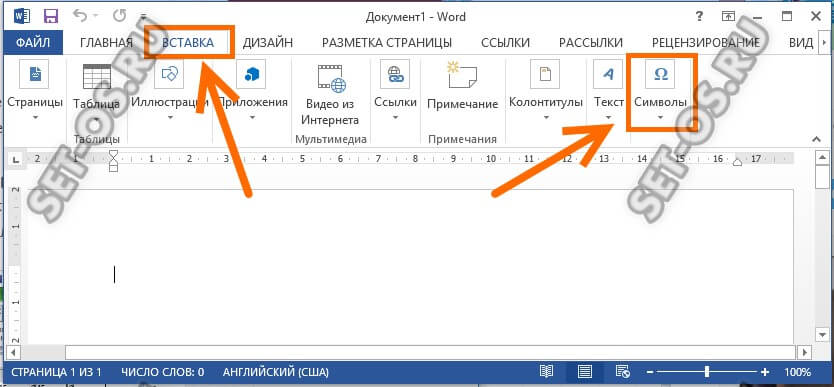
In the panel that opens, select the "Symbols" subsection. This menu will open:

In it, you must select the item "Other symbols". The symbol table window will appear:

To insert a diameter symbol, you must either find it in the table manually, or using the “Symbol code” field. Enter the “diameter” symbol code in it - 00D8 and the required circle icon is automatically found and highlighted.
Instructions
Use a special component operating system Windows, which is called "Character Map". The link to launch it can be found in the main menu on the Start button - after opening it, go to the All Programs section, then to the Standard subsection, and then to the Utilities section, where you will find a link with this name. Another way is to press the key combination win + r, enter charmap in the open program startup dialog and press the Enter key.
Find the icon in the table diameter... Please note that there may be several characters similar in style - at least two (depending on the typeface installed). On the first page, you can find two options - select the most suitable one and double-click it, and then copy it to the clipboard by clicking the "Copy" button.
Switch to the document window where you want to enter sign diameter and paste it from the clipboard by pressing ctrl + v or ctrl + Insert.
You can do without the symbol table if you know the associated sign y the code is in the coding table. At Microsoft Office Word you can enter a hexadecimal code, then press alt + x and the word processor will replace the code with its corresponding icon. The hexadecimal codes 00D8 and 00F8 correspond to the two icons you found on the first page in the symbol table.
Use mnemonic character codes to insert icons diameter to html pages. For example, if you put a sequence of characters ∅ or ∅ in the document code, the result will look like this for a page visitor: ∅. A symbolic primitive ⊕ or ⊕ looks like this: ⊕, ⊗ or ⊗ - ⊗, Ø or Ø - Ø, ø or ø - ø.
Sign diameter found in the drawings and accompanying documents with him. It is not available in all code tables, and is completely absent on the keyboard. This sign has to be introduced in an indirect way.
Instructions
If the diameter of a metric thread is indicated, a special character is not required. Use a capital letter M. instead.
To enter a character diameter if using office suites OpenOffice.org Writer, Abiword and Microsoft Office Word, open the symbol table. To do this, use the menu item called "Insert" - "Special character" or similar. Find the sign in the table diameter and if that fails, try to find it in a different font. After that click on this symbol and then on the OK button, and it will be inserted.
To enter a sign diameter when typing in the browser input field, as well as when working with HTML code in the file editor TXT format, run one of the above-mentioned office suites, type in it the sign diameter using the symbol table, then select it with the mouse, copy it to the clipboard by pressing Ctrl + C, navigate to the desired place in the edited text, and then paste the character from the clipboard by pressing Ctrl + V. This technique works only if the document is edited in Unicode encoding... Note that Notepad may not support this encoding. Use Geany, Kwrite (on Linux), or Notepad ++ (on Windows) instead.
You can also take the sign diameter straight from this paragraph: ⌀. Select it, copy to the clipboard and paste from the latter into the document, as indicated above.
How to insert characters into Word text
diameter, stress, quotation marks or apostrophe ...
Word character table
Selecting a symbol from the table is a classic way of inserting symbolic characters into the text of the Word: set the cursor to the desired place in the text, open the tab-menu of the Word "Insert", click consecutively, as in the picture: "Symbols", "Symbol", "Other symbols". The "Symbol table" will appear, in which you need to click (click) on the required symbol and press the "Insert" button. The selected character will appear in the text Word document... To view the entire table Word characters- use the side slider.
Selecting and inserting symbols from a table is a simple but time consuming procedure. Word text editor character table is crammed with all sorts of rubbish, in which it is simply unthinkable to quickly find the desired icon.
Mr. Unicode allows you to insert printable and non-printable characters and symbols from the keyboard. Unicode character codes (keyboard shortcuts) support almost all text editors, from notepad to Photoshop. In the table of Word symbols, the code of the selected symbol is displayed in a special window (6), see fig.
Apparently, from the words "a set of keys" - half of the inhabitants of the Internet falls into a trance. However, if a person is more than five years old, and he already knows letters and numbers, this is not difficult. Quite the opposite - there is a quiet buzz from the wild time saving. Codes of frequently used symbols can be written out on a piece of paper and stupidly trampled on "Klava", without going into the details of any menus.
To insert the required character or symbol - set the cursor to the desired place in the text, hold down (press, trample, do not release) the "Alt" key and, in the digital part of the "keyboard" - sequentially type the code of the character. Let go of the "Alt" key - the required character will immediately appear in the text.
Some popular symbols:
- "English double quotes": 0147 and 0148
- ‘English single quotes’: 0145 and 0146
(right english single quote
used in Ukrainian as an apostrophe:
podvir'ya, suzir'ya, bur'yan) - "Russian quotes (Christmas trees)": 0171 and 0187
- "Quotation marks": 0132 and 0147
- - simple dash: 0150
- - em dash: 0151
A broader picture of an example of using the keyboard when entering characters is given by the Word character table in Unicode:
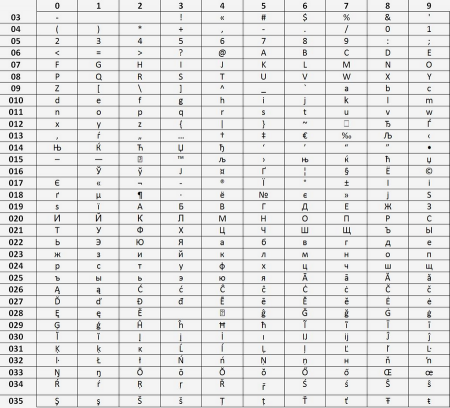
An example of using a table:
alt + 1 = ☺; alt + 2 = ☻; alt + 3 = ♥; alt + 4 = ♦; alt + 5 = ♣;
alt + 6 = ♠; alt + 7 =.; alt + 8 = ◘; alt + 9 = ○; alt + 10 = ◙; etc.
Tens are indicated on the left, and ones on the top. To insert a symbol - place the cursor in the text, hold down the "Alt" key and, without releasing it - the symbol code. Then - release the "Alt" key, and - the required icon will appear in the text line.
Attention! Enter the character code exclusively in the right numeric part of the keyboard. In this case, it must be turned on (activated)!
Find and enable (activate)
right numeric keypad
Right Numeric Keypad - Right numeric keypad on a regular computer keyboard... These keys are assigned functions that are not available at the top. numeric keypad, in particular - entering a digital code. By default, the right numeric keypad is inactive. To activate the digital block, use the "Num Lock" key. Each repeated pressing of "Num Lock", alternately - activates / deactivates (turns on / off) the right number keys. In laptops (especially netbooks), the right number pad is often missing. Numeric keys, or combined with the main keyboard, or the function of entering numeric codes is carried by other keys on the main unit. Activating key "Num Lock", on laptops - also may not be.
However, the right numeric keypad cannot completely disappear from the computer device. It is simply hidden and deactivated for the convenience of the user. The surest way to find out how to enable and activate the right number pad functions is to ask the manufacturer.
Otherwise, we call the "On-Screen Keyboard", which is always, everywhere and in everyone. The on-screen keyboard is located, something like this: Start Menu / (System Tools, Standard) / Accessibility / On-Screen Keyboard.
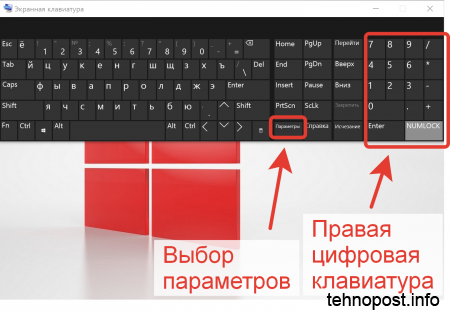
The on-screen keyboard usually displays the actual state of the real keyboard. On on-screen keyboard there may not be a right number pad and a "Num Lock" key. Not scary. Press the "Options" key on the on-screen keyboard (see the figure above). A dialog box will open where you need to check the box to enable the numeric keypad. We press "OK" - the digital block will appear on the screen. Press "Num Lock" - the keyboard is activated.

Insert stress into Word
An accent mark is inserted in a separate ass in the Word text:
- Place the cursor after the desired letter
- We type (print) the symbol code: 0300 or 0301 (tilt left / right).
The numbers of the code will be displayed directly in the text.
Do not touch, do not remove the cursor. - Hold "Alt" and then - "X"
(in the Russian layout - "H") - An accent icon will appear above our letter.
On this moment, only Word supports the accent mark. In other text editors, you can insert an accent mark by copying it ready-made from Word text... In Notepad, the copied character, accents are not saved to the file ...
Use Notepad ++ ...
Diameter sign in Word
At the moment, Word does not support the diameter sign, as well as all other text editors. Instead of the classic diameter symbol (crossed out circle), it is generally suggested to use the good old crossed out zero: Ø Ø ... Visually, it is practically indistinguishable, and for programmers - one less headache. They (the programmers), and the crossed out zero, came up with something solely to distinguish the numbers 0 (zero) from the letter O... And then there is this awful diameter mark (crossed out circle), completely indistinguishable from the crossed out zero. For this, the sign of the diameter has sunk into oblivion. The only way to insert into Word text true diameter mark (crossed out circle) - copy it from old documents when this icon was supported by a text editor. Download: word.zip (downloads: 30) to copy the diameter sign. As for the strikethrough zero, it is entered with a set of keys, of the form: "Alt" + 0248 (lower case - ø ), "Alt" + 0216 (uppercase - Ø ). You need to type hot keys, certainly in the English keyboard layout. Otherwise there will be a letter NS !!!
V text editor MS Word has a fairly large set special characters, which, unfortunately, not all users of this program know about. That is why, when it becomes necessary to add a particular symbol, sign or designation, many of them do not know how to do it. One of these symbols is the designation of the diameter, which, as you know, is not on the keyboard.
All special characters in Word are in the tab "Insert", in a group "Symbols", to which we need to turn for help.
1. Place the cursor where you want to add a diameter icon in the text.
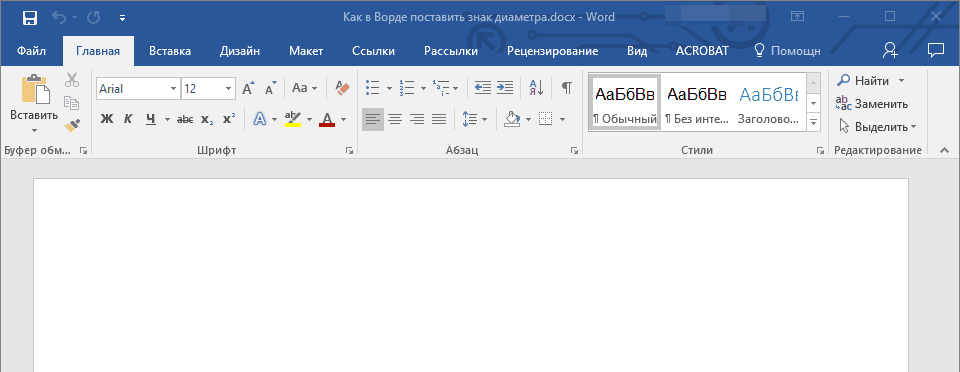
2. Go to the tab "Insert" and click there in the group "Symbols" on the button "Symbol".

3. In the small window that will expand after clicking, select the last item - "Other symbols".
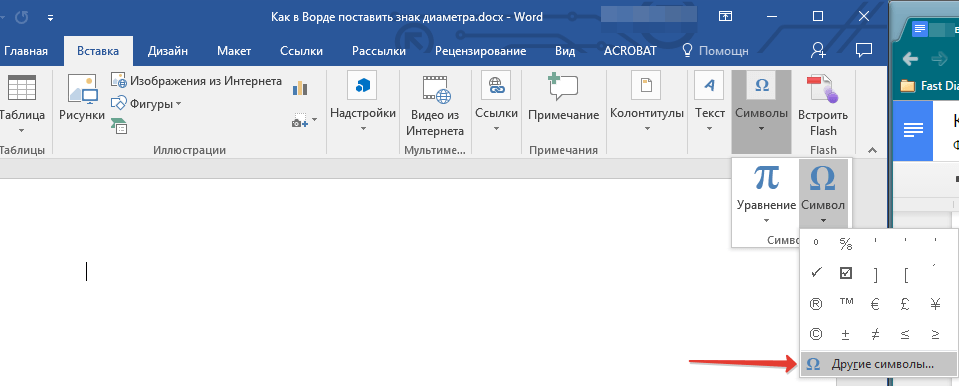
4. A window will open in front of you "Symbol", in which we have to find the designation of the diameter.
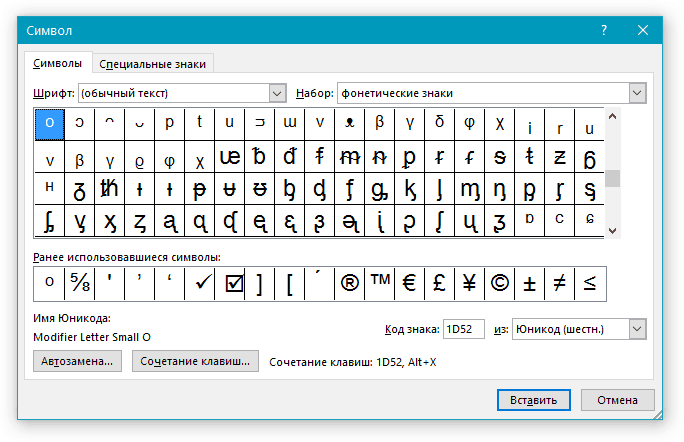
5. In the section "Kit" select item "Supplemented Latin-1".
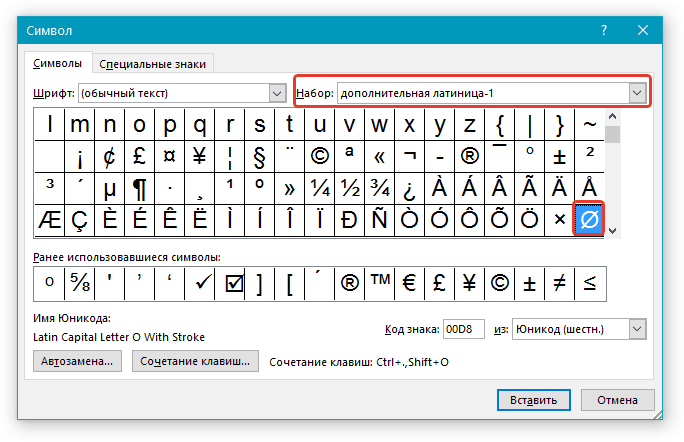
6. Click on the diameter icon and press the button. "Insert".
7. The special character you selected will appear in the document at the location you specified.

Adding a diameter sign using a special code
All characters that are in the section "Special characters" Microsoft programs Word have their own code designation. If you know this code, you can add the required character to the text much faster. You can see this code in the symbol window, in its lower part, by first clicking on the symbol that you need.
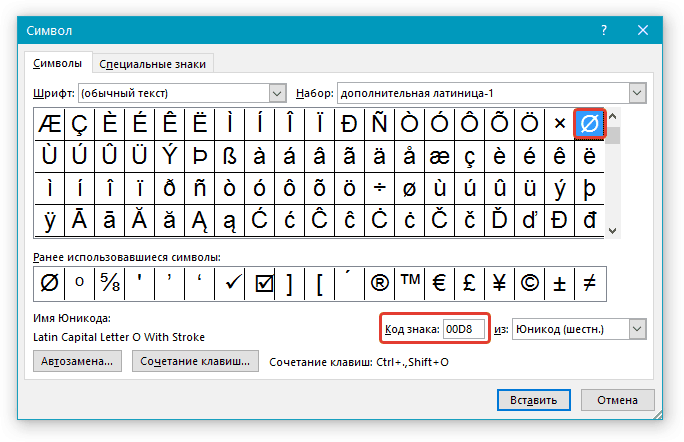
So, to add a “diameter” sign using code, do the following:
1. Position the cursor where you want to add a character.

2. Enter in English layout combination "00D8" without quotes.

3. Without moving the cursor from the set position, press the keys "Alt + X".
4. The diameter mark will be added.
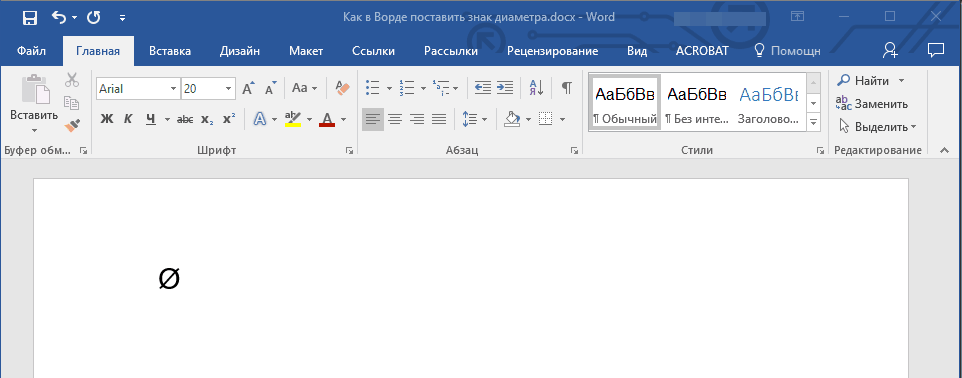
That's all, now you know how to insert the diameter icon into the Word. Using the set of special characters available in the program, you can also add other necessary characters to the text. We wish you every success in your further exploration of this advanced document management software.
Not all symbols are located on the keyboard. The diameter icon is also missing on it. But this does not mean that it cannot be inserted into most modern applications. There is such an opportunity. Moreover, this operation can be done completely different ways... The most versatile of these is the use of ASCII codes. The second method is tied to the office suite of Microsoft and works only in it. The last method is related to. To implement it, you need the original diameter icon, which will then be copied and pasted into the new application. Each method will be discussed in detail within the framework of this article.
When does this need arise?
There are many cases in which it becomes necessary to insert the “Ø” sign in For example, it may be needed when drawing drawings, preparing price lists, creating advertising bouquets or explanatory notes for pipe products or valves. This list can be continued further, but it is clear that, although not so often, but
insert into electronic document the diameter icon is sometimes necessary.
Using codes
The most universal way is based on the use of ASCII codes. It is implemented by the capabilities of the operating room itself. Windows systems, therefore it is not tied to any one, strictly defined application. First you need to remember a special code - "0216", which corresponds to "Ø" in the ASCII code table. And the order of input in this case is as follows:
- Change the input language until “En” (“English”) appears. If this is not done, then instead of "Ø" will be entered "Ш".
- Next, turn on the numeric enhanced keyboard. Its activation is signaled by the "Num Lock" LED. If it is on, then nothing needs to be done.
- Then we go to the work area of our application, if it is minimized. To do this, just click on it in the taskbar. Then we move the pointer of the manipulator over its working area and make one click with the left button. At the same time, the cursor should blink in it.
- At the next stage, hold down the "Alt" key (no matter from which side, you can either left or right). Then, without releasing it, sequentially on the right numeric keypad, type "0-2-1-6". We completely remove our hands from and after that the diameter icon should appear.

The main advantage of this method is its versatility. It works in most modern programs... There is no need to search for the original symbol. The disadvantage of such a solution is that you need to remember the code. If only one of this icon is required, then there is no problem. Worse if there are several of them. In this case, it is best to print out the most commonly used symbol code table on a sheet of paper and use it periodically.
Word and other office applications
The alternative way to enter "Ø" is tied to a specific group software products... This is an office suite from Microsoft, which includes Word, Excel and other applications. Let's introduce the diameter icon in the "Word" as an example. In other cases, the entry procedure is the same. In the process, go to the toolbar called "Insert". It is located at the top of the screen between the Home and Page Layout tabs. Move to this inscription and make a single left-click. Then on the right side of the screen we find the "Symbols" sub-panel. On it, select the item "Symbol" and in the list that opens, select "Other symbols". All these manipulations are performed right click mice.
An insert window will open. In it we find the "Ø" we need by scrolling through the symbols. This can be done using a special wheel or by repeatedly pressing the left button of the manipulator on the strip on the right. When we have found "Ø", select it by single pressing the left button of the manipulator and press the "Insert" button (located in the lower right part of the window). Then we close the window. After that, the diameter icon should appear in Word (in its work area). The downside to this method is that it only works in one group of applications. Therefore, it will not be possible to use it everywhere.

Clipboard
Another way of pasting "Ø" is based on using the clipboard and a combination of the "Copy" and "Paste" operations. First you need to find this symbol somewhere. For example, you can insert a diameter icon in the "Word" in accordance with the previously described technique. Then select it and copy it (you can use the keyboard shortcut "Ctrl" + "C"). Then go to another application and use the paste operation ("Ctrl" + "V"). The downside of this solution is that you need the original symbol. And he is not always available.
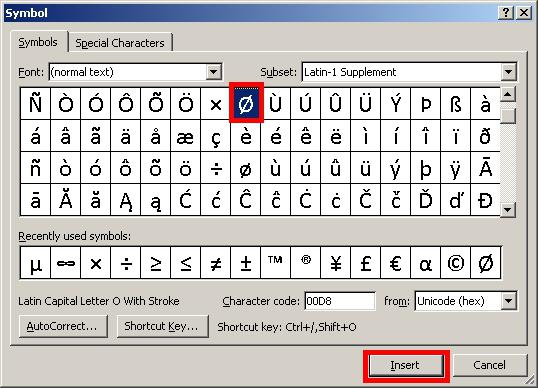
Finally
There is no diameter icon on the keyboard. But it can be entered without any problems in one of the three suggested ways. The simplest and most versatile of them is based on the use of so-called ASCII codes. It is not tied to a single application and works in almost all programs of the operating system.
 Bugs in Singularity?
Bugs in Singularity? Just Cause 2 crashes
Just Cause 2 crashes Terraria won't start, what should I do?
Terraria won't start, what should I do?